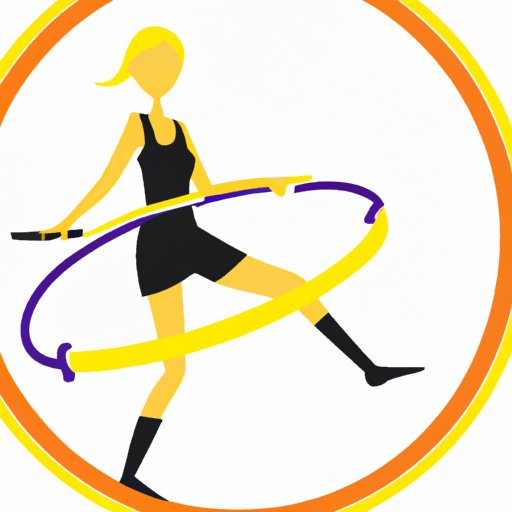Introduction
Hula hooping has been around since the 1950s and is a fun way to exercise. It is a low-impact activity that can help improve balance, coordination, and flexibility. It is also a great way to burn calories, strengthen your core, and tone your body. In this article, we will explore the history and science behind hula hooping for fitness, discuss whether or not it is a viable exercise option for all ages, provide a beginner’s guide to hula hooping, and explore the different types of hula hoops and their benefits.

History and Science Behind Hula Hooping for Fitness
The hula hoop was invented in 1958 by Richard Knerr and Arthur Melin, founders of Wham-O, Inc. The first hula hoops were made from stiff, heavy plastic tubing that was designed to be whirled around the waist. They quickly became popular with children and adults alike, and the craze soon spread across the United States and other parts of the world. Today, modern hula hoops are much lighter and come in a variety of sizes and materials.
Hula hooping is a type of aerobic exercise that works your entire body while providing cardiovascular benefits. When you hula hoop, you use your core muscles to keep the hoop spinning around your waist. This helps build strength and stability in your abdominal muscles, back, and hips. Additionally, hula hooping can help improve coordination and balance as you work to maintain your center of gravity while spinning the hoop.
Is Hula Hooping a Viable Exercise Option for All Ages?
Hula hooping is an excellent form of exercise for people of all ages. It is easy to learn and can be done at home or outside. Hula hooping is a great way for kids to stay active and have fun. For adults, hula hooping can provide a low-impact workout that is both challenging and enjoyable. It is also a great way to relieve stress and reduce anxiety.
When it comes to safety considerations, it is important to ensure that the hula hoop is the right size for your body. A hoop that is too big can be difficult to control, while a hoop that is too small can cause strain on your muscles. Additionally, it is important to make sure that you have the proper technique when hula hooping. If you are new to hula hooping, it is best to start slowly and gradually increase your speed and intensity as you become more comfortable with the movement.
Beginner’s Guide to Hula Hooping for Optimal Workouts
If you are just getting started with hula hooping, there are a few key things to consider. First, it is important to choose the right hula hoop for your body size and fitness level. You should also make sure that the hoop is made of quality materials that won’t break easily. Additionally, it is important to practice proper technique when hula hooping. This includes keeping your arms close to your body and using your core muscles to move the hoop around your waist.
Once you feel comfortable with the basics of hula hooping, you can start to add different exercises and movements to your routine. Basic exercises include hula hooping in circles, side steps, and figure eights. You can also try more advanced moves such as knee lifts, leg swings, and arm circles. As you become more comfortable with hula hooping, you can increase the speed and intensity of your movements to challenge yourself further.
Incorporating Hula Hooping into Your Existing Routine
Hula hooping can be a great addition to any existing fitness routine. It can help you reach your fitness goals and can even be used as a form of cross-training. Before you start hula hooping, it is important to set realistic goals for yourself. This will help you stay motivated and give you something to strive for as you progress. Additionally, it is important to make sure that you are incorporating hula hooping into your regular fitness regimen. Aim to hula hoop at least three times a week for optimal results.

Exploring the Different Types of Hula Hoops and Their Benefits
There are many different types of hula hoops available on the market today. Each type offers its own unique benefits. Some of the most popular types of hula hoops include weighted hula hoops, foam hula hoops, and collapsible hula hoops. Weighted hula hoops are great for building strength and toning your body. Foam hula hoops are ideal for beginners as they are lightweight and easier to control. Collapsible hula hoops are great for those who travel frequently as they can easily be taken apart and stored in a backpack or suitcase.

Health Benefits of Regular Hula Hooping
Regular hula hooping can provide numerous physical, mental, and emotional benefits. Physically, hula hooping can help strengthen your core, improve balance and coordination, and increase flexibility. It can also help you lose weight, tone your body, and improve your overall fitness level. Mentally, hula hooping can help relieve stress and improve focus. Emotionally, hula hooping can boost self-confidence, reduce anxiety, and lift your mood.
Conclusion
Hula hooping is a fun and effective form of exercise that can provide numerous physical, mental, and emotional benefits. It is an activity that can be enjoyed by people of all ages and skill levels. By choosing the right hula hoop for your body size and fitness level, practicing proper technique, and incorporating hula hooping into your existing routine, you can get the most out of your workouts.


